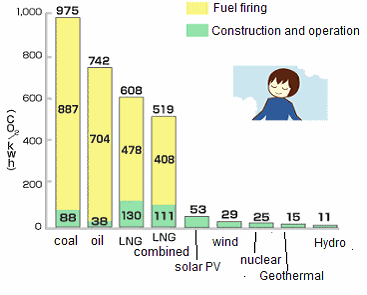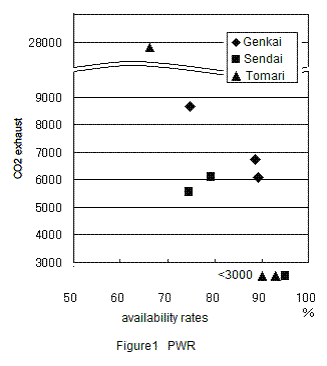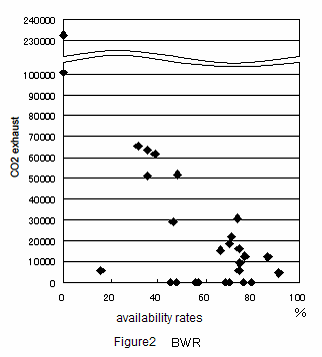Nuclear power plants in Japan don't become Global warming measures
1. Life cycle CO2 emissions per kWh of Nuclear Power Generation
(1) Evaluation by Central Research Institute of Electric Power Industry (CRIEPI), Japan
 Measures for global warming are used for the excuse for promotion of nuclear
power. For example, In the Webpage entitled "Nuclear power make low
carbon society", Kansai Electric Power Company shows a graph of CO2
emission according to various power supplies, LC-CO2 emissions per kWh
are coal 975éç, oil 742g, solar PV 53g, wind power 29g, nuclear 25g. Company
appeals that the emission of nuclear is less than that of solar PV or wind
power.
Measures for global warming are used for the excuse for promotion of nuclear
power. For example, In the Webpage entitled "Nuclear power make low
carbon society", Kansai Electric Power Company shows a graph of CO2
emission according to various power supplies, LC-CO2 emissions per kWh
are coal 975éç, oil 742g, solar PV 53g, wind power 29g, nuclear 25g. Company
appeals that the emission of nuclear is less than that of solar PV or wind
power.
I visited last year the Low Carbon Expo held in Banciao City, Taipei, Taiwan.
I was surprised that Taipower exhibited the panel that shows same emissions.
If the country is different and the condition is different, emissions are
different, but the PR was a copy.
The source of the PR is a report of The Central Research Institute of Electric
Power Industry(CRIEPI) managed by investment of electric power company,
published in 2001.The report says the LC-CO2 emission per kWh of nuclear
power plant. The evaluation is done under the condition of nuclear fuel
cycle including reprocessing in Japan, MOX fuels fabrication, MOX fuels
one time use, HLW storage and HLW disposal. But the condition has not been
achieved in Japan.
Meanwhile, the evaluation of solar PV and wind power is done under the
condition of an average technology at the time of 1996. CRIEPI report says
emission of solar PV has the possibility of becoming half, and wind power
becoming 70 üô, by the production expansion. One is a value when the future,
and a past other value. Is it impartial?
I think CRIEPI report has a lot of other problems. The evaluation of nuclear
is done by assumption of which the loss doesn't go out in each process
such as Uranium mining, refinement, conversion, concentrate, re-conversion,
molding, reprocessing. This assumption is a desk theory. The calculation
includes HLW disposal, but there is no energy consumption after the HLW
disposal site is closed. EPA(USA) says that the restriction of one million
years for HLW is necessary. Even if HLW disposal site is closed, monitoring
is not necessary? CO2 emission 0 is impossible. Because of the HLW disposal
site is not decided somewhere, Transportation to the disposal site is not
included in the calculation.
CRIEPI report says because the evaluation changes greatly depending on
the precondition, you should interpret the result after understanding enough
the influence that the change in the precondition gives the result.
CRIEPI updated the evaluation based on data in fiscal year 2009, published
in July this year. LC-CO2 emissions per kWh are coal 943éç, oil 738g, solar
PV 38g, wind power 25g, nuclear 20g. These figures will be used for PR
in the future.
(2) In research results of the world
According to Professor Kenichi Oshima at Ritsumeikan University, Prof. Sovacool reviewed 103 researches published in English that estimates greenhouse emission from nuclear power plant. He excluded the researches that passed ten years and the research based on unpublished data, the researches that fill the same standard is 19. According to 19 researches, LC-CO2 emissions per kWh of nuclear is 1.36g or more, 288.25g or less, and 66g on average. He was pointing it out that the evaluation changes which range of the nuclear fuel cycle included, and depend on method of uranium enrichment with large amount of energy use, type of reactor.
Table1ü@CO2 emissions (g/kWh)
|
Life cycle |
Exhaust at chance by delay |
Exhaust by war,terrorism, and carbon leakage |
total |
| Solar PV |
19ü`59 |
0 |
0 |
19ü`59 |
| Solar thermal power |
8.5ü`11.3 |
0 |
0 |
8.5ü`11.3 |
| Wind power |
2.8ü`7.4 |
0 |
0 |
2.8ü`7.4 |
| Geothermal power |
15.1ü`55 |
1ü`6 |
0 |
16.1ü`61 |
| Hydro power |
17ü`22 |
31ü`49 |
0 |
48ü`71 |
| Wave power |
21.7 |
20ü`41 |
0 |
41.7ü`62.7 |
| Tidal power |
14 |
20ü`41 |
0 |
34ü`55 |
| Nuclear |
9ü`70 |
59ü`106 |
0ü`4.1 |
68ü`180.1 |
| Coalü\CCS |
255ü`442 |
51ü`87 |
1.8ü`42 |
307.8ü`571 |
After all, the emission of the nuclear is smaller than the emission of thermal power generation, but larger than the emission of solar PV and wind power.
2. Realities of CO2 exhaust from nuclear power plant in Japan
To examine the results value of Japan, I claimed indicating, and analyzed the greenhouse emission in 2006 ü` 2008, based on Global warming measures promotion law.
Nuclear power plant that the amount of the energy use is over crude oil conversion 1500kl/year: as shown in the Table2.
Table2ü@CO2 emissions of Nuclear Power Plant üit- CO2/yearüj
| Name of Power Plant |
Reactor type |
2006FY |
2007FY |
2008FY |
| Energy origin CO2 |
Before allocation |
Energy origin CO2 |
Before allocation |
Energy origin CO2 |
Before allocation |
| Tomari |
P |
- |
- |
- |
- |
27800 |
0 |
| Higashidori |
B |
19100 |
6430 |
19300 |
7030 |
24300 |
5500 |
| Onagawa |
B |
71700 |
6210 |
8380 |
8380 |
4770 |
4770 |
| TokaiçU |
B |
16300 |
0 |
11500 |
7030 |
16100 |
6750 |
| FukushimaçT |
B |
65700 |
65500 |
59600 |
59400 |
42800 |
42600 |
| Kashiwazaki Kariwa |
B |
8780 |
8780 |
4980 |
2740 |
241000 |
8470 |
| Hamaoka |
B |
77300 |
13600 |
12900 |
12900 |
11500 |
11500 |
| Shiga |
B |
60199 |
8548 |
109000 |
8300 |
70900 |
9220 |
| Tsuruga |
P,B |
30900 |
0 |
29203 |
0 |
50840 |
0 |
| Shimane |
B |
25200 |
9920 |
16500 |
10700 |
32200 |
10200 |
| Genkai |
P |
8654 |
0 |
6742 |
0 |
6068 |
0 |
| Sendai |
P |
- |
- |
6100 |
0 |
5534 |
0 |
| total |
ü@ |
383833 |
118988 |
284205 |
116480 |
533812 |
99010 |
P:PWRü@B:BWR
Kashiwazaki Kariwa nuclear power plant was struck by the Chuetsuoki earthquake in 2007. The plant exhausted sulfur hexafluoride enclosed with the transformer. The plant had stopped completely in 2008, but the plant has exhausted a large amount of CO2 because of the restoration construction. The Shiga nuclear power plant also had stopped completely in 2007, it was the largest amount of the exhaust in this year.
It is a lie that Nuclear power plant doesn't exhaust CO2 when electricity is generated.
Table2 is shown by "Indirect exhaust" method. The amount of the
CO2 exhaust when electricity is generated from the power plant is distributed
to the final consumption section. "Before allocation" shows amounts
actually exhausted from power plants. There are actual exhausts from most
BWR. Those are from auxiliary boilers those are the main equipment. For
BWR, to prevent radioactive steam leak, steam generated by auxiliary boilers
seal the space between turbine axle and casing when nuclear reactor is
started and stop. The fuel of auxiliary boiler is a crude petroleum or
electricity. The auxiliary boilers always move to use it also for heating
buildings, waste management facilities, and outdoor tanks etc. The auxiliary
boilers of FukushimaçU are all electricity, there is no data from FukushimaçU.
Most BWR always burn the crude petroleum as a fuel of auxiliary boilers
and have exhausted CO2.
PWR mainly exhausts CO2 by the energy use for periodic overhaul. PWR of
the table2 have multiple reactors, so I show the relation of the average
availability of multiple reactors and amount of the CO2 exhaust in Figure1.
For BWR, auxiliary boilers exhaust doesn't relate to availability, so I
show the relation of the value subtracted auxiliary boiler exhaust from
gross discharge and availability rates in Figure2. You can see the amount
of the exhaust increases when availability rates falls. Because of the
availability rates of the nuclear power plant in Japan are 60% level recently,
a large amount of exhaust is expected.
 |
ü@ |
 |
In the data disclosed this time, the data such as Rokkasyo reprocessing
plant is included. The amount of the exhaust by the reprocess trial run
is a large value. There are constant exhaust from decommissioning "Fugen"
and fast breeder reactor "Monju". The exhaust from the process
of the nuclear fuel cycle that has not been established yet and the research
and development are also large. The amount of CO2 exhausted from the entire
nuclear power cannot be disregarded.
Table3ü@Greenhouse emissions of Nuclear fuel plant etc. üit- CO2/yearüj
|
2006FY |
2007FY |
2008FY |
| 4 nuclear processing plants total |
29276 |
27813 |
27992 |
| Rokkasyo uranium-enrichment plant |
26400 |
19500 |
17700 |
| Rokkasyo reprocessing plant |
227000 |
201000 |
211000 |
| fast breeder reactor "Monju" |
26797 |
40562 |
48780 |
| advanced thermal reactorü@"Fugen" |
16831 |
17245 |
19390 |
| Japan Atomic Energy Agencyü@other laboratories total |
275440 |
145560 |
301720 |
| total |
601744 |
451680 |
626582 |
Nuclear power plant cannot do the output adjustment and become only the power supply of the base loading. It is said that if one nuclear power plant is increased, 2 or 3 thermal power plants are necessary, because nuclear power plants have the crisis of the stop together by an accident and a scandal. After all, it is expected that the thermal power plant is increased with the nuclear power plant, and the exhaust of CO2 increases. To achieve the low carbon society, the reduction in a total energy consumption is indispensable. Promotion of nuclear power only extends the energy waste structure.
top of this page
This report written in September 2010 for NO NUKES ASIA FORUM held in Taiwan
HOME
 Measures for global warming are used for the excuse for promotion of nuclear
power. For example, In the Webpage entitled "Nuclear power make low
carbon society", Kansai Electric Power Company shows a graph of CO2
emission according to various power supplies, LC-CO2 emissions per kWh
are coal 975éç, oil 742g, solar PV 53g, wind power 29g, nuclear 25g. Company
appeals that the emission of nuclear is less than that of solar PV or wind
power.
Measures for global warming are used for the excuse for promotion of nuclear
power. For example, In the Webpage entitled "Nuclear power make low
carbon society", Kansai Electric Power Company shows a graph of CO2
emission according to various power supplies, LC-CO2 emissions per kWh
are coal 975éç, oil 742g, solar PV 53g, wind power 29g, nuclear 25g. Company
appeals that the emission of nuclear is less than that of solar PV or wind
power. 
